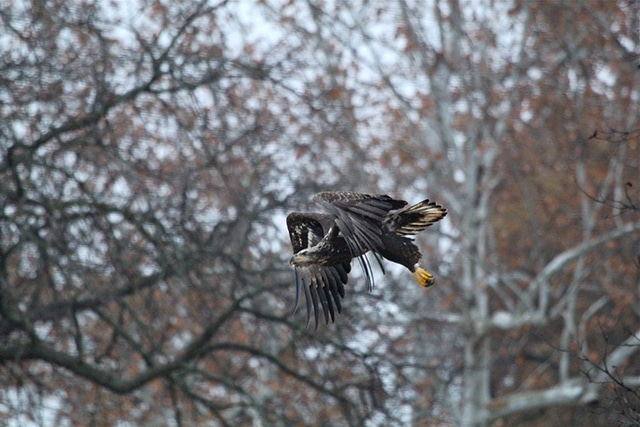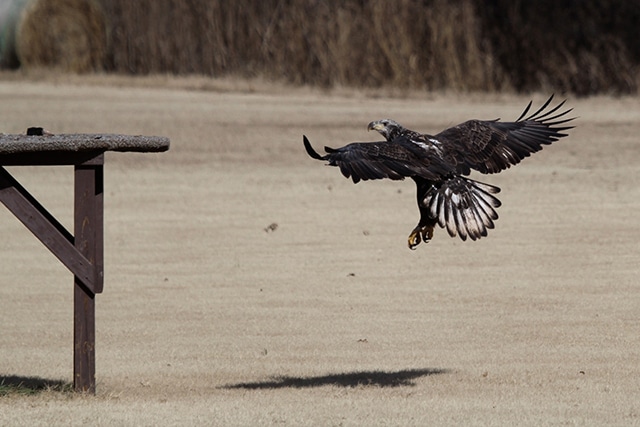 As the sun begins to peak over the horizon, the aviary pasture is already busy in the grey daylight. More than a dozen deer graze while the resident tom turkeys are busy courting several hens as the eagles begin calling. However, these were not a greeting for the morning sun but frenzied calls that usually signal other wild eagles passing through. Searching the sky, we spot Wadasé Zhabwé in the big pecan tree out back, but the commotion was not for her alone. There is an adult male bald eagle flying above her. He continues past her, landing in the big cottonwood tree out front. Although neither stays for very long, they both continue northeast towards the spot where Squirrel Creek meets the North Canadian River. This time of year, several ducks and coots gather in the shelter of the wide bend in the river. The new telemetry information from Wadasé is a good indication that she knows too. Because we know she chased a previous suitor off many times here at the aviary, we are fairly certain that this interaction is merely a social one. But it is good to see her with other adults. These eagles have survived on their own with the benefit of learning from wild parents and they can teach her about local food sources in different seasons that she may not have discovered on her own.
As the sun begins to peak over the horizon, the aviary pasture is already busy in the grey daylight. More than a dozen deer graze while the resident tom turkeys are busy courting several hens as the eagles begin calling. However, these were not a greeting for the morning sun but frenzied calls that usually signal other wild eagles passing through. Searching the sky, we spot Wadasé Zhabwé in the big pecan tree out back, but the commotion was not for her alone. There is an adult male bald eagle flying above her. He continues past her, landing in the big cottonwood tree out front. Although neither stays for very long, they both continue northeast towards the spot where Squirrel Creek meets the North Canadian River. This time of year, several ducks and coots gather in the shelter of the wide bend in the river. The new telemetry information from Wadasé is a good indication that she knows too. Because we know she chased a previous suitor off many times here at the aviary, we are fairly certain that this interaction is merely a social one. But it is good to see her with other adults. These eagles have survived on their own with the benefit of learning from wild parents and they can teach her about local food sources in different seasons that she may not have discovered on her own.
 Wadasé continues to follow the same routine since she returned from the Salt Fork River near Ponca City, Okla. Since Oct. 6, she has yet to fly more than 35 miles from the aviary. She spends most days along the North Canadian River when she isn’t here. She stops by often, and on occasion she will spend the better part of the day perched here as if watching over the aviary grounds. She has not eaten several of the days that we have offered her food when she visits. In fact, many mornings she arrives with a full, bulging crop. That full crop, which is visible when filled unlike our stomach, tells us she has already had breakfast on her own. She is far from the days when she depended on us to supplement her food. However, we have noticed on days when we have significant weather moving into the area she is more inclined to stay and eat her fill here at the aviary. All of this is a positive sign of her good instincts in action. To weather any storm we all fair better if we are prepared. Filling up the day before the storm means that she can stay perched in the inclement weather conditions, conserve energy and hunt again when the weather breaks or simply come back to the aviary. She has a wing up on wild eagles now. Her experience in captivity has not hindered her but has led to her having the advantage of added support in the wild if she chooses. We feel exceptionally blessed to have her home for the holidays as she allows us to continue to share this place with her.
Wadasé continues to follow the same routine since she returned from the Salt Fork River near Ponca City, Okla. Since Oct. 6, she has yet to fly more than 35 miles from the aviary. She spends most days along the North Canadian River when she isn’t here. She stops by often, and on occasion she will spend the better part of the day perched here as if watching over the aviary grounds. She has not eaten several of the days that we have offered her food when she visits. In fact, many mornings she arrives with a full, bulging crop. That full crop, which is visible when filled unlike our stomach, tells us she has already had breakfast on her own. She is far from the days when she depended on us to supplement her food. However, we have noticed on days when we have significant weather moving into the area she is more inclined to stay and eat her fill here at the aviary. All of this is a positive sign of her good instincts in action. To weather any storm we all fair better if we are prepared. Filling up the day before the storm means that she can stay perched in the inclement weather conditions, conserve energy and hunt again when the weather breaks or simply come back to the aviary. She has a wing up on wild eagles now. Her experience in captivity has not hindered her but has led to her having the advantage of added support in the wild if she chooses. We feel exceptionally blessed to have her home for the holidays as she allows us to continue to share this place with her.
Keep your eyes out this winter season near the waterways. If there are fish in the water, there is a good chance there are eagles nearby. One of those eagles could be Wadasé. We have enjoyed hearing the reports of sightings from community members and we continue to encourage you to share those with us.
To follow her movements with us you can visit www.arcgis.com/home and search for “Potawatomi eagle.” Send your encounters with Wadase or any other eagles in the state or wherever you may be to Jennifer.randell@potawatomi.org.
For more information or to read previous updates please visit https://www.potawatomi.org and search the site for Wadase or visit https://www.potawatomi.org/about-wadase
